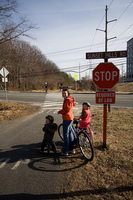

Photo by The Bywaters on Flickr.
Here’s a simple suggestion to improve the morning rush hour: Get more kids to walk, bike, and bus to school.
It is estimated that 20% of morning traffic congestion in Fairfax County is related to parents driving kids to school, and despite the availability of alternates, drop-off lines are only getting longer.
No one wins under the current system. Taxpayers pay too much for kids to get to school, parents lose valuable time serving as chauffeurs, and kids forfeit an opportunity to learn independence and healthy habits. And, of course, everyone suffers when traffic swells.
For the time being, there are almost no programs or policies in Fairfax that promote an alternative to the curbside drop-off. In fact, at several schools, principals prohibit students from walking or biking to school, even though Fairfax County has endorsed these options.
Within the county, elementary school students living more than a mile from school, and middle and high school students living more than a mile and a half, are entitled to bus service. Those within close proximity of their schools have the option to walk routes deemed safe by the county, with buses provided if the journey is deemed hazardous, no matter the distance.
And yet, despite these accommodations, according to Fairfax County Public Schools (FCPS), nearly 60% of designated walkers and just over 30% of designated bus riders frequently use the kiss & ride method instead.
As a result, taxpayers pay multiple times for students to get to school. They pay teachers and administrators to staff large-scale kiss & ride operations, while at the same time they pay for the empty bus seats that students and their parents choose to forgo. Meanwhile, they also pick up the indirect costs associated with increased traffic congestion and on-road incidents.
There are many reasons why walking and biking to school benefit children and the community. Children develop independence at an earlier age, they get the health benefits of exercise, they are more alert in school, and they develop a lifelong healthy habit of walking or biking.
While there will always be many parents who need to drive children to school for a wide variety of reasons, FCPS can encourage more students to walk and bike by addressing the safety and logistical concerns of parents that lead so many of them to drive their children to school.
MWCOG is working to address this issue by experimenting with a new system called School Pool that will help parents find other parents to form bike trains, walking school buses, and regular car pools.
Likewise, FABB, Fairfax’s bicycle advocacy group, and others are working with FCPS to develop a more streamlined process for applying for Safe Routes to School funds. FABB is also trying to communicate to parents the costs of driving kids to school, as well as the benefits of walking and biking.
If you want to learn more about Safe Routes to School activities in Fairfax visit the Fairfax Safe Routes to School Facebook page.
Top image: Photo by The Bywaters on Flickr.